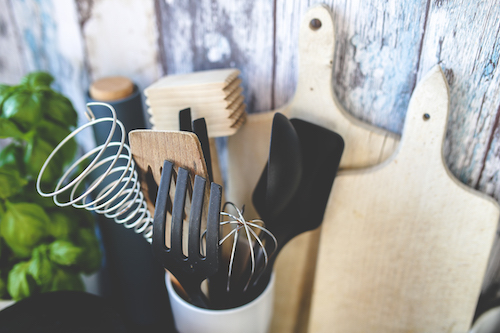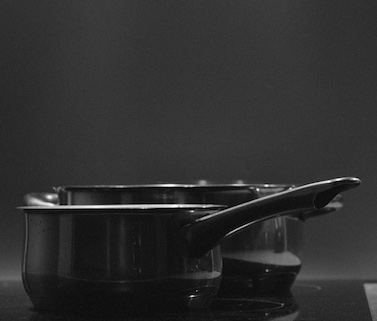How to Declutter Your Kitchen in No Time

Your kitchen needs your help! It’s the time of year when your kitchen works overtime, not just by helping you prepare holiday snacks and meals, but by serving as the location of intimate chats with visiting family and friends. That’s why the time is ripe for a kitchen decluttering!
Start by grabbing some unwanted boxes or plastic bags and plastic storage bins you’ll want to keep (laundry baskets will do in a pinch!). You’ll be filling the boxes and bags with items you’ll want to donate, while the plastic bins will be useful for moving items you want to keep elsewhere in your house where you’ll want to display or store them.
Next, grab your kitchen timer and set it for about 45 minutes if you’re feeling adventurous, 30 minutes if that’s all the time you can spare. The kitchen timer will keep you focused on the tasks at hand, and will help keep you from getting sidetracked by the recipes you’ll suddenly discover buried in the back of a kitchen cabinet!
Feel free to turn on some music or maybe a podcast and ready, set, go:
Top This
Open your kitchen cabinets and give everything inside the once-over, asking yourself these questions as you go:
- Do I use this?
- Do I have more of these than I need?
- Would I buy this again today if I saw it in a store?
- Can I live without it?
The answer to these questions will determine where to place the items you’re assessing. If you’ve decided you use it frequently, don’t have more than you need, would buy it again, and you want to keep it, then you just need to determine where the item should “live.” Keep it where it is? Move it to another spot in the kitchen or somewhere else in the house? If it’s the latter, place the item in your “moving” box or bin.
If you know you no longer need the item, place it in your donation box, where it can soon be put to use helping America’s veterans. That includes everything from plates and saucers that are missing their mates, to glasses and coffee mugs that are no longer your style.
Counterpoint
The countertop is next up on your declutter agenda. You’ll want follow the same process as before, methodically assessing everything in sight. Chances are, you have a catch-all container that’s overflowing with small utensils that you need to either hide away in a drawer or place in your donation box.
Don’t ignore the stack of cookbooks you may have on display. Are there any you haven’t opened in months? If so, you should consider donating them, so another family can try the recipes you’ve grown accustomed to.
Down Under
You’re almost done! Take a shortcut to finishing by opening all the kitchen drawers at once, then scan through each one, moving items into their proper drawers if need be — that rogue potholder doesn’t belong in the small utensils drawer! Keep a sharp eye out for the kitchen gadgets and items you never use. Maybe that extra cheese grater and cutting board could be put to use in another home, so donate them! By sifting through your items, you’ll also be clearing up space in your drawer organizers, which will then allow you to finish up by putting all the knives, forks, spoons, and everything else in their proper place.
Bottom’s Up
We’ve saved the scariest places for last — the kitchen cabinets beneath the drawers that often serve as the last resting spot for the bigger items you no longer use. Take for instance the deep fryer that was a hand-me-down from grandma, or the coffeemaker that went into storage after you received your Keurig last Christmas. Don’t forget that electric griddle that was easy to cook on, but way too time-consuming to clean. All of these items should be placed in your boxes or bags for donation.
Now that you’ve freed up some space, you’ll be able to stack your pots, pans, and casserole dishes neatly. Then coordinate your pie pans, cookie sheets, and muffin tins and check to see if they are ready for their close-ups this coming baking season. If they’re still in good shape, store them together; if not, off to the garbage they go — but not until you add any usable but unneeded ones to your donation collection.
Finish up by diving under the sink, where you probably keep the cleaning supplies you’ve just used. While you’re down there, it’s a good idea to inspect your drain pipes coming down from the sink, to make sure the seals are still tight and there is no leakage.
By now your kitchen timer’s ready to strike zero, and your kitchen’s in the best shape it’s been in months. Congratulations! Now all you need to do is take the bin containing your “relocate” items and move around your house, dropping them off in their proper place. Once that’s complete, take your donation boxes and bags and go ahead and mark them with “VVA,” so the Pickup Please drivers will know what to take away from your porch or driveway. Then, on the day you scheduled your free donation pickup, be sure to place your kitchen stuff, as well as your gently used clothes, books, shoes, jewelry, and household items in their donation boxes and bags outside. Not only will you have a decluttered kitchen, you’ll be helping to support America’s veterans.
America’s Best Donation Pickup Program



